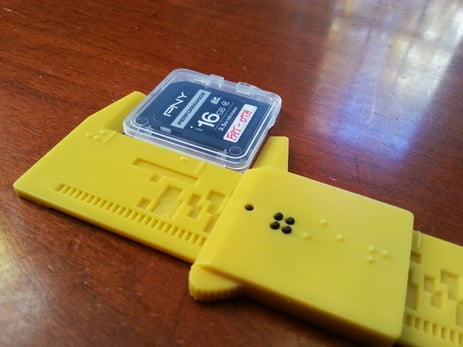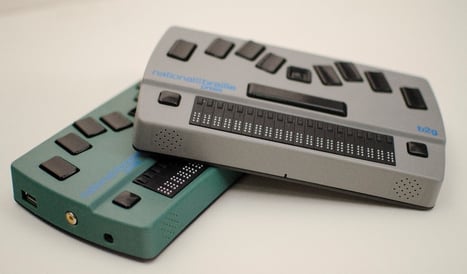One of these days a blind or low vision person will be able to read on their device a periodical like National Geographic or Newsweek, or even a textbook or standardized test, and not only will the information be translated into braille and displayed in full page format, but the device will also instantly produce tactile images or graphics. ‘When pigs fly’ some of you say—but the response shouldn’t be ‘it’s impossible,’ it should be, ‘when will it happen?’
Every year National Braille Press produces thousands of pages of braille for tests and textbooks including hard copy raised tactile graphics for students. Unfortunately, the ability to render tactile images in real time on a device has not yet come to fruition, at least not with the affordability or resolution that is really needed to be effective. However, that long search for the ‘Holy Braille’ is finally starting to show some exciting promise.
Amazing advances in technology are leveraging new, affordable approaches to raise a braille pin or to render an image in unconventional ways, and we at NBP have created the Center for Braille Innovation (CBI) to act as a global information broker and champion for just such breakthroughs in engineering design. We want blind students and adults in the workplace to have the same tools as their sighted peers, and to be able to compete and experience the ‘Internet of Things’ like everyone else, so we build the partnerships needed to keep us on the cutting edge.
Through the CBI we have built relationships and partnerships with the University of Michigan, MIT, IBM, Google, Northeastern University, India, China, and others to find the right mix of components and features that can be leveraged to create a tablet for the blind—and that can be manufactured affordably. Economies of scale are a critical fact of life in the affordability of a product, and if it can be built into existing, mainstream products with a universal design, everyone wins.
Through a relationship with an Indian company founded by two MIT doctoral engineers, we launched the Tactile Caliper, a low cost, mechanical, refreshable braille ruler that allows accurate measurements to the 1/16th of an inch (a metric version is also in the pipeline).

And in partnership with the innovative Deane Blazie, we launched the B2G earlier this year, our first refreshable braille consumer electronic product.
The B2G uses a conventional piezo-electric method to raise braille pins, but our design also allows for OEM options for any future successful methodology. We developed it for two reasons: First, we wanted to lower the price for consumers so that more people could afford this indispensable tool. Second, we wanted consumers to have control over customization; our B2G allows them to add or delete the apps they want and to change user features to suit their own, individual needs. For example, customers can use the Echolink app to turn the B2G into a ham radio station.
 Last week an Anheuser Busch semi-tractor trailer delivered 2,000 cases of Budweiser beer on a 120-mile journey without a human at the wheel. This robotic delivery of beer shipped through Denver to Colorado Springs and was called “uneventful.” The technology revolution is in full swing and unfortunately the blind and low vision world has not been top of mind for many designers. Yes, driverless cars and trucks will be an indirect and valuable benefit for BVIs and PWDs, but that wasn’t the motivation to create them. We believe that access to information, especially e-braille outputs, must be included in all products and we will never stop advocating for and championing new technologies that have the potential to serve the blind community.
Last week an Anheuser Busch semi-tractor trailer delivered 2,000 cases of Budweiser beer on a 120-mile journey without a human at the wheel. This robotic delivery of beer shipped through Denver to Colorado Springs and was called “uneventful.” The technology revolution is in full swing and unfortunately the blind and low vision world has not been top of mind for many designers. Yes, driverless cars and trucks will be an indirect and valuable benefit for BVIs and PWDs, but that wasn’t the motivation to create them. We believe that access to information, especially e-braille outputs, must be included in all products and we will never stop advocating for and championing new technologies that have the potential to serve the blind community.So, one of these days you may be zipping down the road in a driverless car, and reading a story on your accessible braille tablet while feeling the raised tactile image of that pig flying after all.
By Brian Mac Donald, President, NBP
